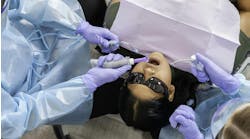by Mary Govoni, CDA, RDA, RDH, MBA
It's been more than a year since the news broke about infection control breaches in an oral surgery practice in Tulsa, Oklahoma. Since then, even more breaches have been reported, in Pennsylvania, New Hampshire, and Hawaii. Some of these instances resulted in the suspension of a dentist's license to practice. The reports all involve improper sterilization of instruments. In light of what appears to be a continuing issue, this is a good time to review the steps of proper instrument sterilization.
1. Cleaning instruments prior to sterilization
The CDC's official infection control guidelines state that instruments should be thoroughly cleaned to remove blood or other debris prior to sterilization. Blood or debris on the instruments can prevent steam or unsaturated chemical vapor from contacting the instrument surfaces to achieve sterilization. The use of enzymatic cleaning solutions will assist in cleaning the instruments.
2. Use and maintain the sterilizer according to the manufacturer's instructions
The manufacturer's instructions for use of the sterilizer must always be followed, or its effectiveness can be compromised. If unfamiliar with the proper operation of the sterilizer, consult the owner's manual or go to the manufacturer's website for this information, not only on the operation, but proper maintenance of the sterilizer.
3. Package all Instruments prior to sterilization
This recommendation from the CDC is the standard of care for patient safety. Packaging instruments is critical in maintaining the sterility of instruments until they are used, whether the instruments are placed directly into a sterilization pouch or in an instrument cassette that is wrapped or placed in a sterilization pouch. Extra instruments that may be stored in the treatment rooms may be contaminated if they are placed loose in drawers and not protected by packaging materials.
4. Place integrators in instrument packages
These are strips that monitor more than one of the parameters required to achieve instrument sterilization. These strips monitor the temperature, as well as penetration of the steam or chemical vapor into instrument packs. Although the sterilizer may be functioning properly, if instrument packs are overloaded or improperly positioned in the sterilizer, every package of instruments may not be sterilized. The only way to validate this is with an integrator.
5. Store instruments away from possible cross-contamination and moisture
Sterile instruments first must be left in the sterilizer until the packaging material has dried to prevent tears or punctures of wet materials and to prevent wicking of air contaminants into the packages. Appropriate storage areas for sterile instruments are closed cabinets or drawers, but not above the sterilizer or near a sink, where the packaging materials may become wet.
6. Spore test sterilizer(s) weekly
The CDC's Guidelines for Infection Control in Dental Health-Care Settings recommends that sterilizers be tested "at least weekly." Although the CDC guidelines are not regulations (e.g., OSHA), they are the recognized standards of care for patient safety. Spore testing can be accomplished with an in-office system or through an outside sterilization monitoring service.
7. Follow CDC protocols for trouble-shooting if a spore test fails
The first thing that must be done if a failure result or report occurs on a spore test is that the sterilizer must be taken out of service until the cause of the failure is determined. Simply following the failed test with another spore test, while using the affected sterilizer, is not appropriate. Sterilizer monitoring services, as well as in-office systems, have support services available for determining the cause of the failure.
Resources
Two well-known and respected companies have recently introduced resources and services to assist dental practices with sterilization issues. They are Crosstex, which introduced the Sterilization Quick Guide and the Recommended Steps for Instrument Reprocessing, which are reference guides that can assist teams in following appropriate sterilization protocols. Also, Hu-Friedy has introduced a complimentary Sterilization Observation service, in which their representatives can come on-site to observe a practice or facility's procedures, evaluate protocols, and provide a report of findings. These can be extremely helpful in identifying potential problems.
In my opinion, one infection control breach is one too many. Take time to evaluate your protocols, so that you don't find your practice on the receiving end of a complaint from a patient and a possible intervention from a regulatory agency.
Mary Govoni, CDA, RDA, RDH, MBA, is the owner of Mary Govoni & Associates, a consulting company based in Michigan. She is a member of the Organization for Safety, Asepsis and Prevention. She can be contacted at [email protected] or www.marygovoni.com.





